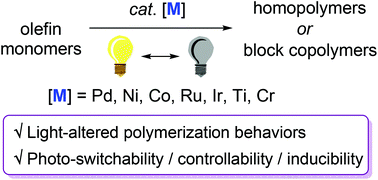Light-mediated olefin coordination polymerization and photoswitches
Abstract
Polyolefins are important polymeric materials in the plastics industry. While classical Ziegler–Natta catalysts are still superior in global polyolefin production, it is challenging to control their polymerization behavior due to intrinsic heterogeneity. A significant number of molecular olefin polymerization catalysts based on transition metals are capable of harnessing polymerization behavior thanks to their finely-tunable ligand sets, where ligand variation acts as electronic and/or steric factors towards the active metal center. Light has been utilized as a green and specific stimulus in the context of coordination olefin polymerization to mainly alter the electronic state of active catalytic sites, which enables photo-controlled chain propagation. A handful of examples of polymerization catalytic systems that have precise controllability under photoirradiation have been developed to provide a broad range of polyolefins in terms of polymeric (micro)structure. In this Review, we wish to outline photo-responsive, transition metal-based coordination polymerization catalysts ranging from homogeneous to heterogeneous, and monometallic to bimetallic regimes. Specific but varied roles of light depending on the employed catalysts for olefin polymerization are presented with a strong emphasis on the photo-altered properties of the active species.

- This article is part of the themed collection: 2020 Organic Chemistry Frontiers Review-type Articles


 Please wait while we load your content...
Please wait while we load your content...